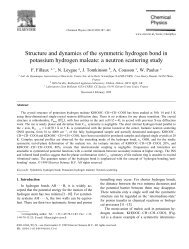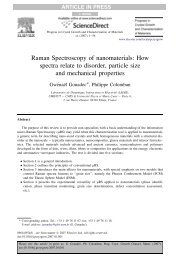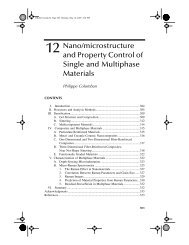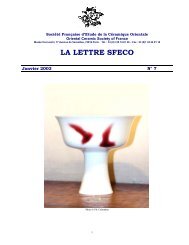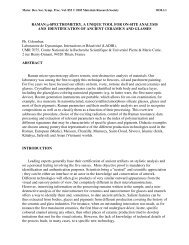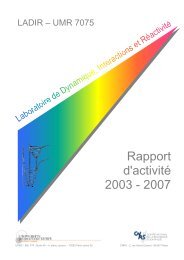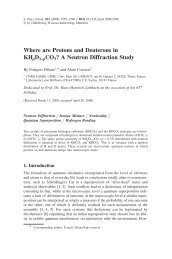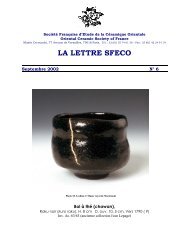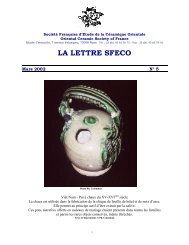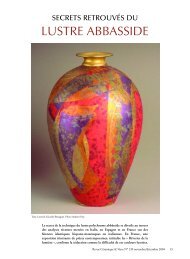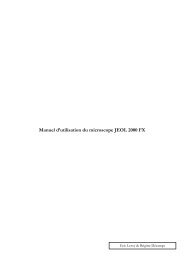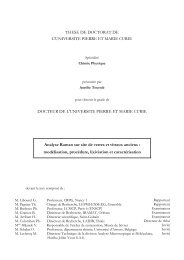Quantum entanglement and nonlocal proton transfer dynamics in ...
Quantum entanglement and nonlocal proton transfer dynamics in ...
Quantum entanglement and nonlocal proton transfer dynamics in ...
Create successful ePaper yourself
Turn your PDF publications into a flip-book with our unique Google optimized e-Paper software.
F. Fillaux / Chemical Physics Letters 408 (2005) 302–306 305Dis<strong>entanglement</strong> removes the ground state degeneracy:the splitt<strong>in</strong>g (E 0 –E 0+ = hm 0t ) is determ<strong>in</strong>ed by theoverlap of U Ik0 <strong>and</strong> U IIk0 , along the m OH coord<strong>in</strong>ate.S<strong>in</strong>ce there is no energy cost, the zero-po<strong>in</strong>t energiesof entangled, |0 + æ, <strong>and</strong> disentangled, |U 0+ æ, states areequal. For each state (11), the two <strong>proton</strong>s are equallydistributed over the four sites. Coherent superpositionof |U 0+ æ <strong>and</strong> |U 0 æ gives rise to oscillations, at frequencym 0t , between tautomers through coherent <strong>transfer</strong> of twohalf-particles, as sketched <strong>in</strong> Fig. 2. The overall balanceis the <strong>transfer</strong> of a <strong>nonlocal</strong> s<strong>in</strong>gle bare <strong>proton</strong> over the<strong>in</strong>ter site distance of 0.7 Å, across a <strong>nonlocal</strong> symmetricaldouble well potential.Accord<strong>in</strong>g to quantum laws, any measurement of<strong>proton</strong> <strong>dynamics</strong> automatically destroys quantum<strong>entanglement</strong>. Therefore, only the disentangled D 2hsymmetry is observable with spectroscopy techniques.However, moments of <strong>in</strong>ertia are identical for the C 2h<strong>and</strong> D 2h structures depicted <strong>in</strong> Fig. 2, as opposed tothose <strong>in</strong> Fig. 1. Therefore, measured moments of <strong>in</strong>ertiaare not conclusive with respect to the actual symmetry.A key issue is to determ<strong>in</strong>e the effective double-wellpotential. The sketch <strong>in</strong> Fig. 2 is so dramatically at variancewith that under consideration <strong>in</strong> theoretical works(Fig. 1) that previously calculated potentials are irrelevant.In addition, the present author is not aware ofany quantum chemistry method able to model <strong>nonlocal</strong><strong>dynamics</strong>.The potential shape can be determ<strong>in</strong>ed from experimentaldata. The double m<strong>in</strong>imum potential splits them OH mode <strong>in</strong> the 3000 cm 1 range <strong>in</strong>to two componentscorrespond<strong>in</strong>g to states |U 1+ æ <strong>and</strong> |U 1 æ, analogousto Eq. (11). Early analysis of the microwave rotationspectra of various carboxylic acid opened-dimers leadto potential barriers of 5000–6000 cm 1 <strong>and</strong> tunnelsplitt<strong>in</strong>g hm 0t 0.5–5 cm 1 for the ground state orhm 1t 50–500 cm 1 for the upper state [24]. For centrosymmetricdimers, the search for tunnel splitt<strong>in</strong>g hasbeen hampered by the prevail<strong>in</strong>g op<strong>in</strong>ion that the <strong>transfer</strong>of a s<strong>in</strong>gle <strong>proton</strong> yields an unrealistic complex composedof a de-<strong>proton</strong>ated carboxylic group bound to adi-<strong>proton</strong>ated one. Nevertheless, Robertson <strong>and</strong> Lawrence[25] have shown that <strong>in</strong>frared spectra of the formicacid dimer are consistent with a symmetrical doublem<strong>in</strong>imum potential with hm 0t 1.5 cm 1 , hm 1t 140 cm 1 , <strong>and</strong> H 6400 cm 1 . However, ow<strong>in</strong>g tothe manifold of b<strong>and</strong> splitt<strong>in</strong>g mechanisms, the assignmentscheme of the OH stretch<strong>in</strong>g b<strong>and</strong>s is controversial.To the best of the present authorÕs knowledge,observation of hm 0t has never been reported <strong>and</strong> more<strong>in</strong>formation is necessary to corroborate this assignmentscheme.Quite similar effective potentials have been obta<strong>in</strong>edfor s<strong>in</strong>gle-<strong>proton</strong> <strong>transfer</strong> <strong>in</strong> crystals composed ofhydrogen bonded centrosymmetric dimers. For potassiumhydrogencarbonate(KHCO 3 ) hm 0t =17cm 1 ,hm 01 = 130 cm 1 , <strong>and</strong> H = 4850 cm 1 [26,27]. For benzoicacid hm 0t =6cm 1 , hm 01 = 100 cm 1 , <strong>and</strong>H = 5000 cm 1 [28]. These values corroborate theassignment scheme of Robertson <strong>and</strong> Lawrence. Tothe least, a tunnel splitt<strong>in</strong>g of 0.003 cm 1 for the formicacid dimer [2] is quite out of range. Hopefully, thepresent Letter will be an <strong>in</strong>centive to seek tunnel splitt<strong>in</strong>g<strong>in</strong> the 1–10 cm 1 region.4. ConclusionNonlocality <strong>and</strong> quantum <strong>entanglement</strong> could be ofcentral importance to <strong>proton</strong> <strong>transfer</strong> <strong>dynamics</strong>, butthese concepts have been overlooked <strong>in</strong> previous works.With h<strong>in</strong>dsight, this is surpris<strong>in</strong>g s<strong>in</strong>ce wave functionsfor normal coord<strong>in</strong>ates are <strong>nonlocal</strong> representation of<strong>dynamics</strong>, logically amenable to <strong>entanglement</strong>. Thesymmetry related <strong>entanglement</strong> is extremely robust:environment or measurement <strong>in</strong>duced decoherence iscont<strong>in</strong>uously counterbalanced by spontaneous re-<strong>entanglement</strong>at no energy cost. This leads to noncommonsensicalconclusions <strong>in</strong>dependent of the systemenergetics.Indist<strong>in</strong>guishability <strong>and</strong> quantum <strong>entanglement</strong> imposeperfect correlation of the two particles (either <strong>proton</strong>sor deuterons), irrespective of coupl<strong>in</strong>g terms. Anentangled dimer is a coherent superposition of tautomers(Schröd<strong>in</strong>gerÕCat) <strong>and</strong> <strong>in</strong>terconversion is mean<strong>in</strong>gless.Dis<strong>entanglement</strong> opens a tunnel<strong>in</strong>g channel forthe <strong>transfer</strong> of <strong>nonlocal</strong> entities with an effective massof 1 a.m.u. (two half-<strong>proton</strong>s) across a <strong>nonlocal</strong> doublem<strong>in</strong>imum potential. This is a nonstatistical manifestationof quantum <strong>nonlocal</strong>ity.Fig. 2. Dynamics of <strong>in</strong>dist<strong>in</strong>guishable nonseparable dimers. Thesystem oscillates between a superposition of C 2h entangled tautomersI <strong>and</strong> II <strong>in</strong> the ground state (a), <strong>and</strong> D 2h disentangled dimers (excitedstate at hm 0t ) with a half-<strong>proton</strong> at each site (b).References[1] S. Sche<strong>in</strong>er, Hydrogen Bond<strong>in</strong>g: A Theoretical Perspective,Oxford University Press, Oxford, 1997.[2] F. Madeja, M. Havenith, J. Chem. Phys. 117 (2002) 7162.



